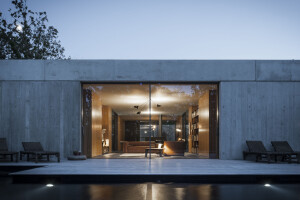The commission is framed within the Programa de Crédito Argentino del Bicentenario (PRO.CRE.AR) housing credit program, for those families who do not have their own plot of land and are willing to have the family's only residence. The site is located in Granadero Baigorria town, in the province of Santa Fe, Argentina, on state land which used to belong to the National Railway System. It is an urban development of 3.3 hectares (81.5448 acres of land), bounded by the rail way on one of its sides, and by an unconsolidated urban fabric on the other side, and framed by heavily tree-covered areas in the rest of the sides. The proposal considers the solution to one of the two sectors into which the piece of land is divided, and it offers buildings with a ground plus 2 floors; ground plus 3 floors, and ground plus 7 floors; with a total of 105 houses and 8 business premises.
The Project acknowledges the issue of the impersonal style in housing complexes and the infinite repetition of dwellings of identical characteristics as opposed to the need of identity and acknowledgment of individuality. That is why, given the prejudice regarding multi-family dwelling complexes as having monotonous, homogeneous and impersonal repeated patterns, and understanding that the perception and experience of diverse architectural scenery gives the user a sense of belonging and the adoption of places, the proposal intends to correct that imminent need of uniqueness and identity.
Following this premise, one of the basic conditions of the design at the start of the project consists of the search of an organizing system of the different dwellings which may admit variations among them, without forgetting the search of an integral morphology that comprises the complexes as a whole. That is why, and without abandoning the basic strategy of mass plan carried out by Agencia de Administración de Bienes del Estado ("State Goods Administration Agency”), an architectural project was launched for the development of an urban proposal which would allow us to go deeper into the hypothesis formulated, based on the program, orientations, views, green areas, interstitial spaces, systems of traffic paths and accesses.
The ground plus 2 floors, and the ground plus 3 floors prototypes adopt similar project strategies, by means of the separation of the vertical circulation and its incorporation to the building mass as empty space volume. In this way, there is not a lineal common circulation which may go across all of the residences, and in that way both facades will be directly facing outside, optimizing air flow. In addition, empty space volumes reaching the ground floor configure entries, enabling a visual and functional bond between the interior courtyards of the complexes street, and optimizing the relationship between the building and its urban surroundings, which allows greater control of the users in terms of the pedestrianized area. This volumetric operation is developed from a typology of duplex houses which change direction from the social area to the sleeping area, which results in a series of communal terraces which serve as interchanges, going through the building and bringing in natural light into the central courtyard.
The ground plus 7 floors building contributes in configuring an urban system of open block, and being located on both sides of the piece of land. In order to improve access conditions, we propose a phase shift of the original piece in the plan, taking its center as section. In this way, the relationship between the building and the street is improved, the ground floor level of the sidewalks in the access area is widened as well as in the business premises. In turn, this break enables the units located in the center of the plan to be like corners and in that way there would be views in both facades. In the elevation, the phase shift of the original piece in the plan is repeated, and as a result the opening of the premises to the street are improved, in that way there is space in the highest floor for the elevator shafts and reserve tanks without them being identified in the the volumetry of the building.
The building system which has been adopted consists of an independent reinforced concrete structure and a closing of face brick. That is not only the most traditional and common method used in the region but it also identifies itself with the old railway stations where the predominance of stonework is a common feature, as it is a noble and long lasting material. In order to accentuate the gaps generated by vertical circulation, it has been decided to give them the same finishing as the internal premises, painted in white, in order to differentiate them from the brick enveloping. As the choice of the building system is a factor in the intended design, there is a search for a correspondence between the project decisions and such building method, so the structure which has been put forward consists of a regular grid which results in efficiently modulated prototypes, looking for a construction rationality which will decrease waste and will allow the use of technologies which are present in the local area.
As from the resolution of the different housing typologies and including the application of the different variables considered, we obtain a fragment of the town where its inhabitants obtain not only a heterogeneous and dynamic urban atmosphere but also enjoy units with the same high desire to live in. The spatial quality is considered in the same way in all prototypes respecting the surface, dimensions of the business premises and the disposition of openings. Ultimately, the intention is to express an architecture which not only favors inhabitants but also the citizen in the offering of possible urban sceneries, understanding the own residential project as the building of urban landscape.










































